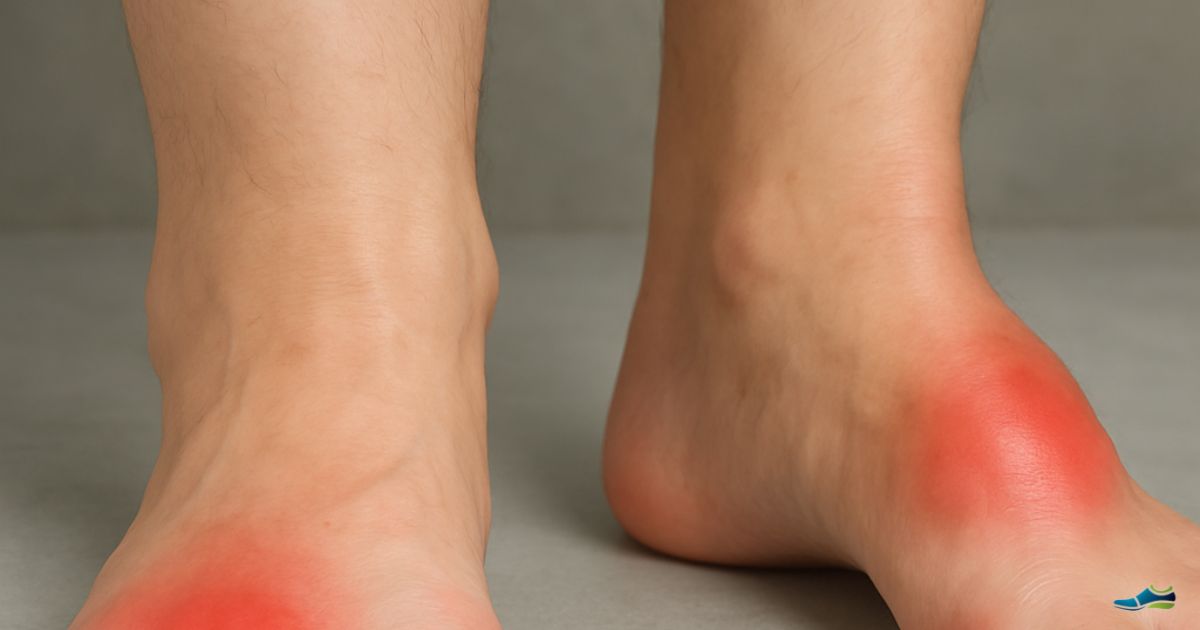Bursitis is the inflammation of a bursa-a small fluid-filled sac that cushions bones, tendons, and muscles near joints. When the bursa becomes irritated or inflamed, it causes pain and restricts movement. Bursitis commonly affects joints like the shoulder, elbow, hip, and heel.
💡 Quick Answers Available
Want the short version? Check out our Bursitis Info Bytes for 20 fast answers to the most common bursitis questions.
Foot Bursitis Symptoms
- Pain and tenderness around the affected joint
- Swelling and warmth in the area
- Stiffness or reduced range of motion
- Increased pain with movement or pressure
Causes of Foot Bursitis?
- Repetitive Motion: Activities that put stress on joints (walking, running, standing) can inflame the bursa.
- Injury or Trauma: A sudden impact or repeated pressure can trigger inflammation.
- Poor Posture or Footwear: Wearing tight or unsupportive shoes can alter foot mechanics, increasing joint stress.
- Medical Conditions: Arthritis, gout, and diabetes can increase the risk.
- Aging: As we age, joint tissues are more prone to wear and inflammation.
Other Management and Treatment Tips
- Rest and avoid activities that worsen pain
- Apply ice to reduce inflammation
- Take anti-inflammatory medications (NSAIDs)
- Use orthotic inserts for better support
- Physical therapy for strengthening and flexibility
- Maintain a healthy weight to reduce joint stress
When to See a Doctor
If your foot bursitis symptoms do not improve with rest and proper footwear, consult a medical professional. In some cases, aspiration, corticosteroid injections, or physical therapy may be required.
How Wide-Fitting Shoes Help with Bursitis
Narrow or tight shoes can compress the feet and irritate the bursa. Wide-fitting shoes provide more space and reduce pressure points. Wearing a wider shoe is one of the most important things you can do to relieve foot bursitis symptoms.
Key Features to Look For:
- Extra width to reduce friction and irritation
- Soft, cushioned insoles
- Low heel drop to improve joint alignment
- Shock-absorbing soles
- Supportive arches to distribute weight evenly
In Summary
- Bursitis is the inflammation of a cushioning sac in the joints, often caused by overuse, poor footwear, or injury.
- It causes pain, swelling, and stiffness, particularly in the feet and heels.
- Wide-fitting shoes reduce pressure and friction, helping relieve and prevent bursitis.
- Combine supportive footwear with rest, ice, and physical therapy for best results.
Q: What are the early signs of foot bursitis?
A: Early signs typically include localized pain and tenderness near the heel or ball of the foot, along with mild swelling and stiffness. Symptoms may worsen with walking, pressure, or prolonged standing.
Q: Can foot bursitis go away on its own?
A: Mild cases of foot bursitis can improve with rest, ice, and supportive footwear. However, if symptoms persist beyond a few days or worsen, medical treatment may be necessary to prevent long-term issues.
Q: Is walking good or bad for bursitis in the foot?
A: Walking can aggravate foot bursitis if the area is inflamed. It’s best to rest during flare-ups and wear wide, cushioned shoes when you resume walking to minimise irritation and pressure on the bursa.
Q: What kind of shoes should I wear if I have foot bursitis?
A: Choose wide-fitting shoes with soft cushioning, shock-absorbing soles, and low heels. Avoid narrow or tight shoes, as they can increase friction and worsen inflammation.
Q: When should I see a doctor for foot bursitis?
A: If your symptoms don’t improve after a few days of rest, icing, and using supportive footwear, it’s wise to consult a doctor. Persistent pain or swelling may require advanced treatments like corticosteroid injections or physical therapy.

